wordpress - what controls the link to /wp-admin?
Beginner users interacting with WordPress go through a hard fourth dimension logging in to their accounts. In this article, I'll explain how to notice your WordPress login URL and a few other essential things that need to be highlighted regarding the login process.
Permit's first from the offset.
Prefer to spotter the video version?
Importance of the WordPress Login
Subsequently installing WordPress, yous'll gain access to your website's admin dashboard, where you have the opportunity to set your site equally you lot need and modify a few things.
This would be incommunicable if you had no access to the admin pages. The login page is what keeps you lot—and others—from accessing the management "side" of your WordPress site.
It is virtually impossible to have full command of your site/blog if you lot have no access to the admin surface area.
But where is this WordPress login page located?
How to Find Your WordPress Login Url:
The WordPress login page tin can exist reached by adding /login/, /admin/, or /wp-login.php at the finish of your site's URL.
If yous installed WordPress on a subdirectory (world wide web.yoursite.com/wordpress/) or subdomain (blog.yoursite.com/), add ane of the 3 paths at the very end of your URL such every bit: world wide web.yoursite.com/wordpress/wp-login.php or blog.yoursite.com/wp-login.php
How to Find the WordPress Login URL
Finding the WordPress login folio is probably more straightforward than you'd expect. On a fresh WordPress installation, adding /admin/ (e.k.: www.yourawesomesite.com/admin/) or /login/ (eastward.g.: www.yourawesomesite.com/login/) at the end of your website's URL will redirect you to the login folio.
Usually, these two should directly have you to your WordPress login page. In case this doesn't happen, there is an additional way to accomplish your login page: you tin add /wp-login.php at the end of the URL, like in this case: world wide web.awesomesite.com/wp-login.php.
How to Detect the WordPress Login URL on a Subdirectory or Subdomain
All of this works for a standard and new WordPress installation. But there'south a run a risk yous might have installed WordPress on a subdirectory of your domain such as www.yourawesomesite.com/wordpress/ or a WordPress subdomain such as blog.yourawesomesite.com/.
If that'southward the case, you lot'll need to append 1 of the same paths right after the subdirectory or subdomain's endmost slash, i.e. the / symbol, to get something like this:
-
www.awesomesite.com/wordpress/login/or -
world wide web.awesomesite.com/wordpress/wp-login.php
No matter which one you're using, any of them should take yous to your WordPress login folio. If you don't want to forget about it, bookmark your preferred URL.
Alternatively, there is a "Remember Me" option in the WordPress login form, which will allow you to stay logged in and reach the admin dashboard for a few days without the need to log in again (based on how your cookies are set):
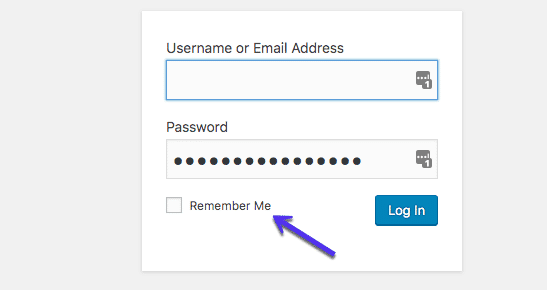
Logging in via the WordPress login folio is a crucial nonetheless easy task to do. If nothing wrong and/or malicious is happening on your site, you'll need your email address/username and your password.
That's all. Unfortunately, bad guys are everywhere, and your site could get a target.
What tin you do to discourage them, then?
Allow's move the login page at least!
How to Modify the WordPress Login Page
Your login page shouldn't be accessible to hackers and malicious attackers (aka the bad guys) because they might get access to your site's admin page and starting time messing things upwardly. Not a expert experience to have, trust me!
While using a stiff, unique, long password can really play in your favor for preventing unauthorized admission to your site, there's never enough things yous could do when security is at stake.
One quick and effective fashion to continue the bad guys out is to move the WordPress login page to a new unique URL. Changing the login URL through which you and your users tin can access your WordPress site could really help when information technology comes to fighting random attacks, hacks, and brute force attacks.
One word near fauna forcefulness attacks: animal strength attacks are hacking attempts where the malicious subject tries to approximate your username and countersign repeatedly, exploiting lists of mutual usernames and passwords that have leaked on the spider web. What they practise is try thousands of combinations taking advantage of scripts that automate all of their attempts.
At that place is a high chance that either your WordPress password or username might be on ane of these leaked lists in today'south globe. If you add together that WordPress login standard URL is something publicly known to this scenario, well, you lot'll get how like shooting fish in a barrel it is to gain access to your WordPress site for hackers and malicious attackers.
That'southward why moving the WordPress login folio to a different path tin can assist you.
Change Your WordPress Login Page with a Plugin
The virtually common and probably easiest mode to alter your WordPress login URL page is past using a free plugin like WPS Hide Login, which more than than 800k users actively use.
The plugin is very lightweight, and more importantly, it doesn't change any files in core or add rewrite rules. It simply intercepts requests. It's also uniform with BuddyPress, bbPress, Limit Login Attempts, and User Switching plugins.

Once downloaded and activated, all you need to exercise is:
- Click on WPS Hide Login from the Settings tab in your right-hand sidebar.
- Add your new Login URL path in the Login URL field.
- Add together a specific redirect URL in the Redirection URL. This page will trigger when someone tries to access the standard wp-login.php page and wp-admin directory while not logged in.
- Hit Save Changes.

An alternative premium plugin you lot tin apply to change your login URL is Perfmatters, adult by one of the team members at Kinsta.
As changing your WordPress login URL tin help to ward off the shallow attackers from accessing your site, I desire to be articulate here: expert and professionals hackers could potentially still go the extra mile and figure out your login page anyway.
So, why should yous care? Well, security is a layers game, where the quality of your hosting plays a key part. the more tools, tricks, walls you have in place, the harder it'll be for the bad guys to pause into your site and gain control.
Changing your login URL can also help foreclose common WordPress errors like "429 Too Many Requests." This is typically generated past the server when the user has sent also many requests in a given amount of time (rate-limiting). This tin can be caused by bots or scripts hitting your login URL. The end-user rarely causes this error.

Change Your WordPress Login Page Editing Your .htaccess File
Other more technical ways to alter or hibernate the WordPress login page URL is by editing your .htaccess file.
Typically used with cPanel hosts, the .htaccess file's main role is to configure rules and set upward system-broad settings. Since nosotros're talking well-nigh hiding the login page, .htaccess tin handle that in two specific ways.
The first ane is most password-protecting your login folio with a .htpasswd so that anyone reaching your login page will be required to put in a password before accessing the login page. If you're a Kinsta client, nosotros use Nginx, and therefore there is no .htaccess file.
You can utilise our htpasswd tool to countersign protect your unabridged site. Or accomplish out to our support team to lock down but your login folio.

The 2d option you lot have is enabling admission to your login page based on a listing of trusted IP addresses.
Limiting Login Attempts
Another constructive security method is to limit the number of login attempts. If you're a Kinsta customer, we automatically ban IPs with more than 6 failed login attempts in a minute.
Or y'all can download a free plugin such every bit Limit Login Attempts Reloaded.
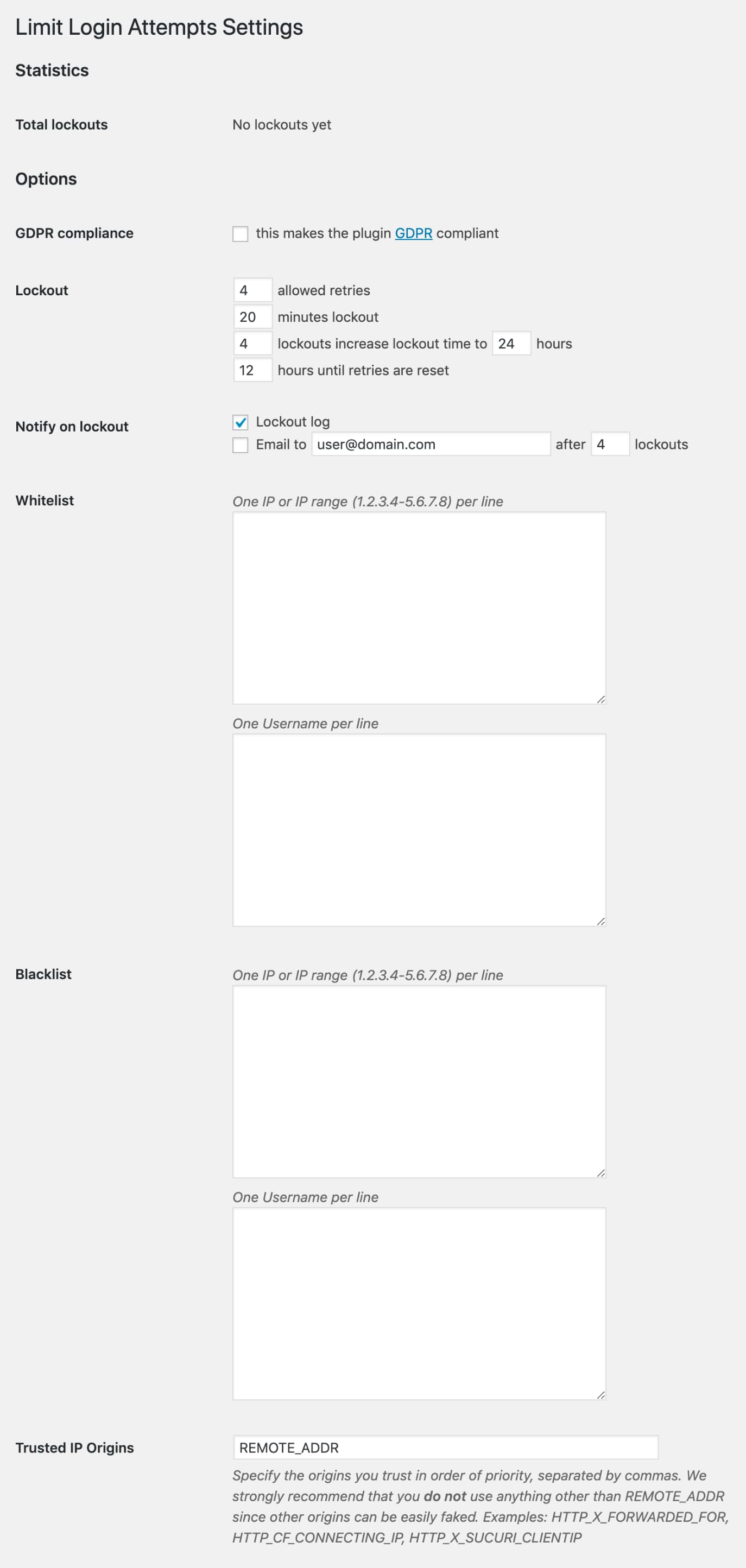
The options in the plugin are pretty straightforward.
Subscribe At present
- Total Lockouts: gives you the number of hackers who tried to pause in, merely failed.
- Allowed Retries: the number of attempts an IP address is allowed to brand earlier you lock them out.
Somewhere between four and six is probably the about popular retry amount. It allows real humans who are supposed to have access to make mistakes (because, after all, we all practise make mistakes when entering passwords), realize they're entering the incorrect password, and ready their error.
It'southward important to set up information technology to the above 2 points, particularly if y'all have frequent guest bloggers or several contributing staff members responsible for managing your site.
- Minutes lockout: how long an IP address will be locked out.
You might like to set it to "forever," simply that's not helpful for people who really do make a genuine error — you want those to be able to let themselves back in eventually. 20-30 minutes is about right.
- Lockouts increase: because if information technology's a Animal Force Attack, information technology's likely to be back.
This function basically says "look," I've seen y'all lock yourself out several times earlier, so now I'thousand going to lock you out for longer." I mean solar day is a good one to go with.
- Hours until retries: how long until it resets everything and lets people try again.
The plugin also lets y'all manage your whitelist, blacklist, and trusted IPs.
How to Fix the Near Common Issues with the WordPress Login
Logging into your WordPress site is a quick and easy task. Yet some users— and you?—might accept experienced some issues when trying to access their WordPress site. Such issues normally fall nether one of the following scenarios:
- Problems related to the countersign
- Issues related to cookies
Permit's have a look at both and see how to address them!
WordPress Login: Password Lost/Forgot
If you're unable to log in, you might have a trouble with your login credentials.
And so, the very get-go thing you should exercise is bank check whether the username and password entries you're typing in are really correct. It'southward a mutual fault made by most of us, though rarely.
Did it piece of work? If not, you might want to change your WordPress password before trying something else. To exercise so, click the Lost your password? link right below the login course:
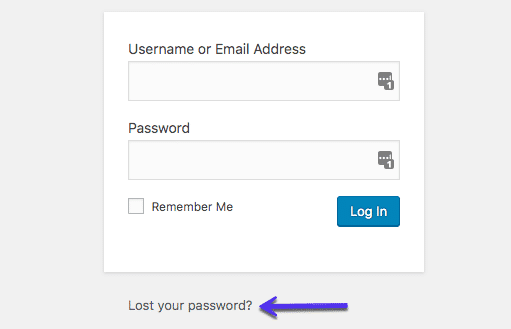
You volition be redirected to a page where you volition be asked your username/e-mail, and a new password will exist sent to you:
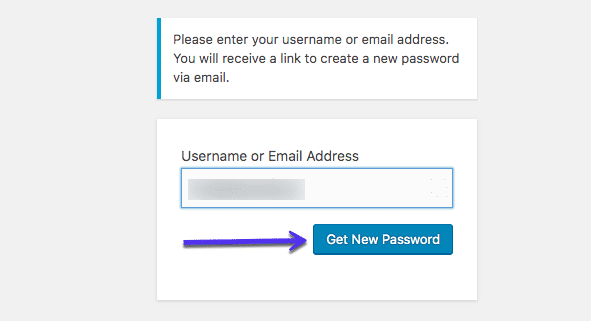
Manually Reset WordPress Password with phpMyAdmin
If this does not piece of work, things volition get a bit more than complicated equally you'll need to acquit a manual password reset. Please don't do this if you lot don't experience comfortable working with database files.
Manually resetting your WordPress login password can be washed past editing the password file on your database. If you take admission to phpMyAdmin in your host, this shouldn't be hard.
Ever fill-in your site before doing any edits to database files in case something goes wrong.
Done? Great!
Pace 1
At present, log in to phpMyAdmin. If you're a Kinsta client, y'all tin can discover the login link to phpMyAdmin within the MyKinsta dashboard.
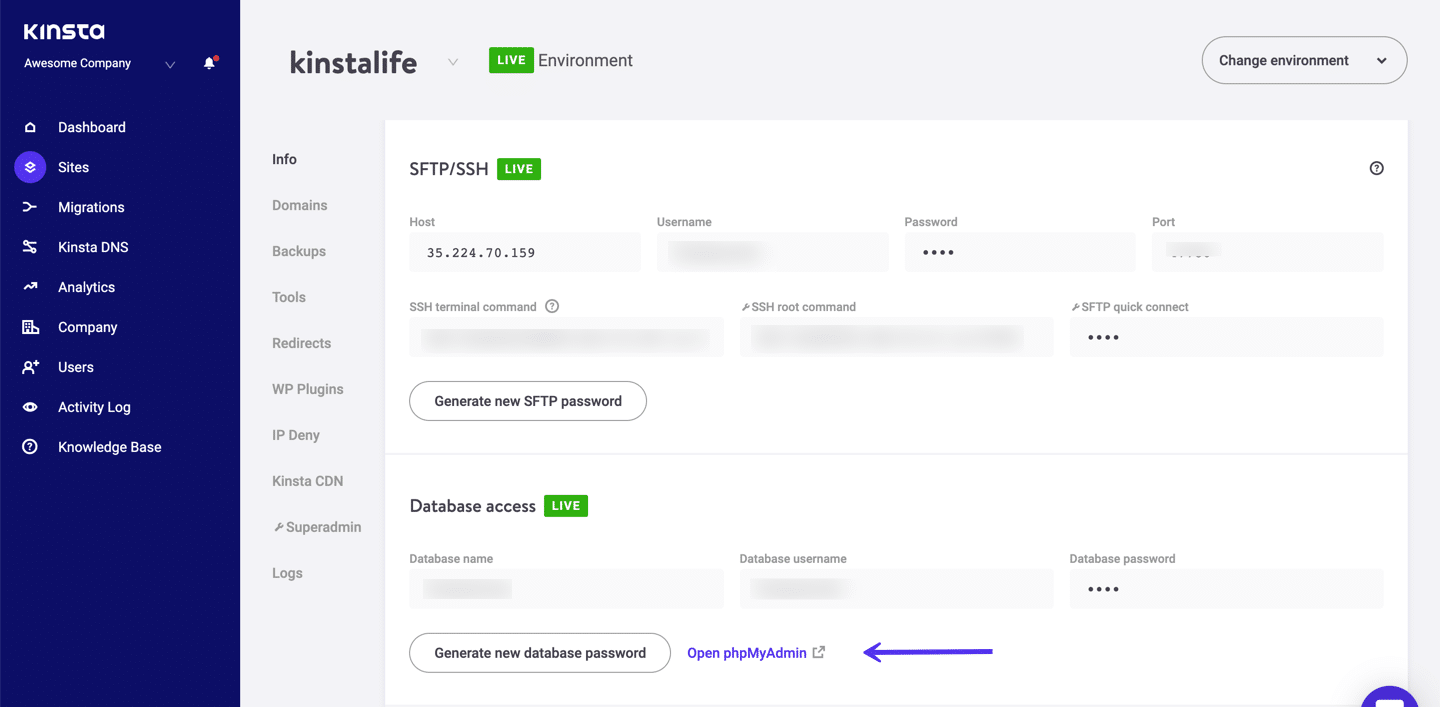
Step 2
On the left-hand side, click into your database. Then click on the table named wp_users. And then click on "Edit" adjacent to the user login yous need to reset.

Step 3
In the user_pass column, enter in a new password (information technology is case-sensitive). In the Part drib-down menu, select MD5. Then click "Go."
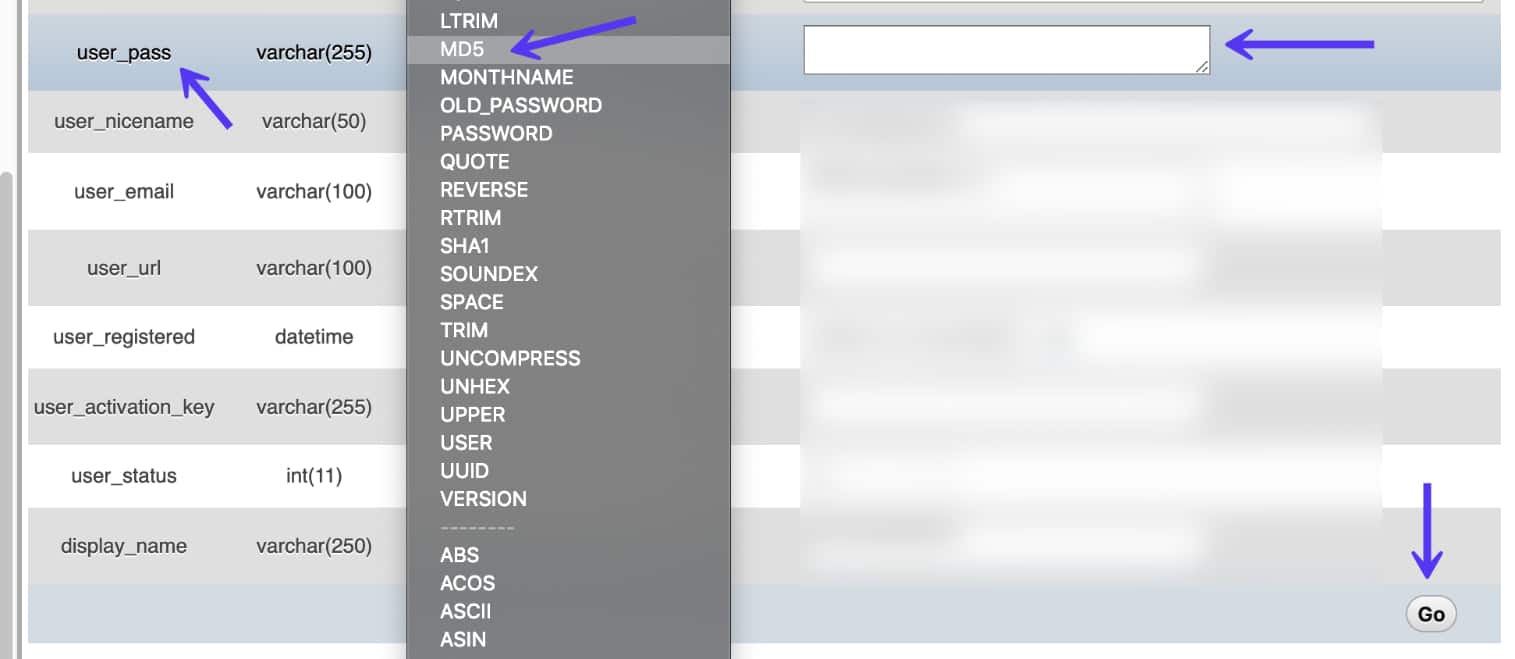
Pace 4
Test the new password on your login screen.
Manually Reset WordPress Password with WP-CLI
Some other way to reset your WordPress countersign is by using WP-CLI. WP-CLI is a command-line tool for developers to manage common tasks (and not and so mutual) of a WordPress installation.
Footstep i
First, employ the following command to listing all of the current users in the WordPress installation.
$ wp user list
Pace 2
And then update the user password with the following command, user ID, and new desired password.
$ wp user update 1 --user_pass=strongpasswordgoeshere
Step three
Test the new password on your login screen.
WordPress Login: Cookies
In some instances, you might not be able to log in due to issues related to cookies. If so, you are commonly met with the following mistake:
Mistake: Cookies are blocked or not supported by your browser. You must enable cookies to employ WordPress.
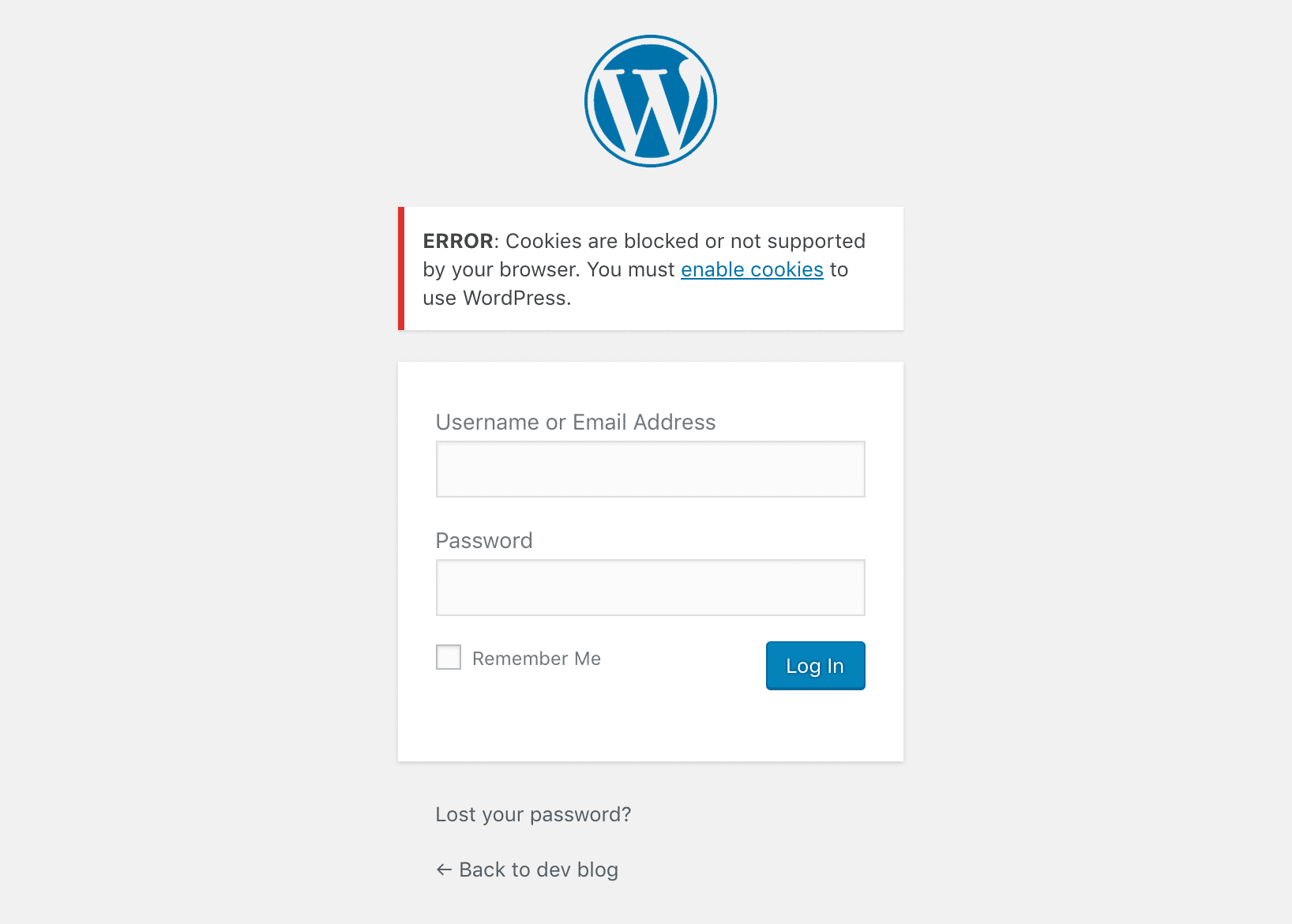
WordPress login relies on cookies to work. If they are disabled or not working correctly, chances are you will take problems on the login folio. The offset thing to check is that cookies are enabled in your browser:
- Cookies in Google Chrome
- Cookies in Mozilla Firefox
- Cookies in Cyberspace Explorer
- Cookies in Safari
We often see this on WordPress sites that have recently been migrated and on WordPress Multisite sites. Sometimes simply refreshing your browser and trying to login again will actually become you by this fault. Y'all could also effort clearing your browser cache or open a dissimilar browser in incognito mode.
If none of the above worked, y'all tin can try adding the line below to your wp-config.php file, correct before /* That'south all, end editing!...*/
define('COOKIE_DOMAIN', false); If information technology'due south a WordPress multisite setup, y'all might want to check and come across if there is a sunrise.php file in the /wp-content/ folder and renamed it to sunrise.php.disabled. This is a file used by an older domain mapping method.
Every bit of WordPress four.v, WordPress Multisite no longer requires a plugin to map domains. If yous're a Kinsta client and unsure near this, please attain out to our support team and ask for help.
Summary
Your WordPress login page is the gateway that grants you access to your site. If you aren't able to log in successfully, you're just a site company.
That's why y'all should learn how to reach this key page so that you lot won't waste product lots of time every time you lot demand to log in to your WordPress site.
Want to improve your security a scrap? Change the standard WordPress login URL with a custom one of your option and share that URL only with trusted people! Also, brand sure to check this guide if WordPress keeps logging you out.
(Suggested reading: How to Change Your WordPress URL)
Relieve time, costs and maximize site performance with:
- Instant assistance from WordPress hosting experts, 24/7.
- Cloudflare Enterprise integration.
- Global audience accomplish with 29 information centers worldwide.
- Optimization with our congenital-in Application Functioning Monitoring.
All of that and much more than, in i plan with no long-term contracts, assisted migrations, and a 30-twenty-four hour period-money-back-guarantee. Bank check out our plans or talk to sales to discover the program that's correct for yous.
Source: https://kinsta.com/blog/wordpress-login-url/
0 Response to "wordpress - what controls the link to /wp-admin?"
Post a Comment